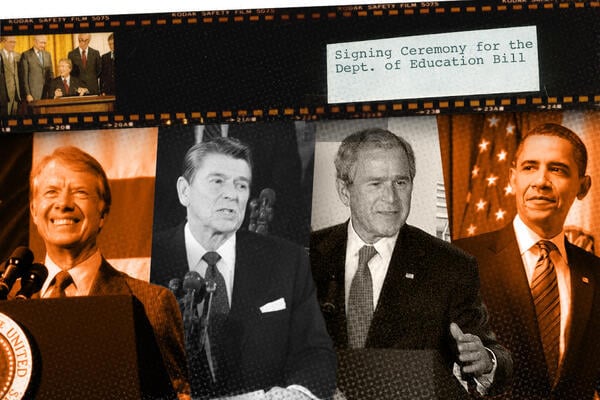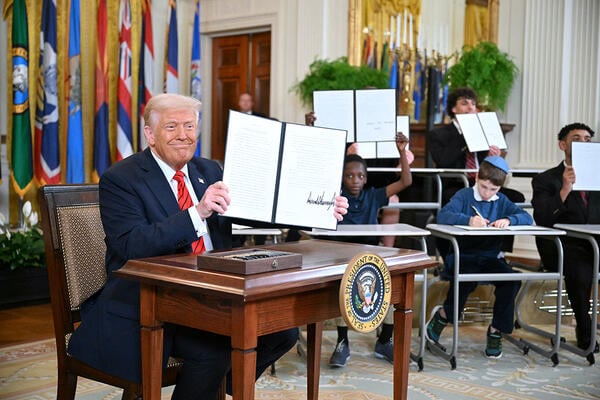
Trump Isn’t First President to Try to Break Up ED
Last week, the Trump administration announced it was moving a raft of Congressionally required Education Department programs to other federal departments—effectively undermining Congress’s aim 46 years ago when it created the department.
It’s a move that has some scholars who’ve studied the history of federal education policy scratching their heads, including about how it relates to the administration’s mantra of “returning education to the states.” They don’t know exactly what the ramifications of this decoupling will be. Some say it could waste time or reduce efficiency—or worse.
They also see Trump’s efforts as the latest chapter in a more than 200-year debate over the federal role in education, including whether to create an Education Department, what should be in it and whether to dismantle it again. There was a version as far back as 1867, established and swiftly eliminated amid civil and states’ rights arguments that continued through the 20th century Civil Rights Era to the 1979 creation of the modern Education Department and into today. This happened while the government got more involved in education in response to the country’s competition with the Soviet Union and now China.
Both Democrats and Republicans have pushed for and against creating the department. After President Jimmy Carter re-established it, Reagan campaigned to destroy it. Then the 1983 “A Nation at Risk” report on issues in U.S. schools appeared to sap that effort, and Reagan’s fellow Republican George W. Bush embraced a strong federal role in “education reform” with the bipartisan No Child Left Behind legislation.
It was created as part of the rebirth of freedom in the United States.”
Derek W. Black, a University of South Carolina law professor
Obama carried on the bipartisan K-12 reform movement, then he and Congress undercut it with new legislation, and the push lost steam. But, along the way, Congress has passed more legislation increasing federal regulation of education, including Trump’s One Big Beautiful Bill Act.
Now Trump—despite pushing other, sweeping education overhauls—is trying to again disband the department, though Congress is unlikely to back him. It’s unclear whether it would reduce the federal government’s role in education anyway.
“A lot of the federal government’s role is tied up in existing legislation,” said Michael Steudeman, an assistant professor in the Department of Communication Arts and Sciences at Pennsylvania State University. He said that “legally, it has certain things that it’s charged to do that—Education Department or no—still will need to happen.”
Steudeman, who studies education policy rhetoric, said dismantling it again is “going to be a very complicated reorganization to accomplish a symbolic goal.” But he also said he thinks the “symbolic leadership role” the department represents “has been really effective and influential over the years.”
Chester Finn, president emeritus of the Thomas B. Fordham Institute and a senior fellow at Stanford University’s Hoover Institution—two conservative-leaning think tanks—called the transfer of functions to other agencies “just pointless and disruptive for no good reason.” He said it’s “confusing to everybody” and “means more doors to knock on and new bureaucracies to learn the ways of.”
“It creates a mess and it adds to dysfunction,” Finn said, adding that “this was never a highly functioning agency, and it certainly needed work to make it better.”
The department says its own dismantlement is just part of the administration’s strategy to return education to the states and improve postsecondary education programs. To Jonathan Zimmerman, a history of education professor at the University of Pennsylvania, “there’s a radical contradiction in the Trump administration’s policy on education.”
“We’re gutting the Department of Ed on the grounds that education should be a state and local concern just like Reagan said, right?” Zimmerman said. “But at the same time, we’re creating unprecedented federal controls on education … The executive orders are unprecedented in the granular way that the feds try to affect what happens both at schools and at universities.”

President Donald Trump holds an executive order directing the dismantling of the Department of Education.
Mandel Ngan/AFP/Getty Images
“The federal government is still gonna have a hand in education, no matter what they say about it being a state and local matter,” Zimmerman said. “And I think because all these functions are being distributed in weird ways and because of these executive orders, I think we should be ready for a roller coaster.”
Marty West, academic dean of the Harvard University Graduate School of Education, stressed that he sees “these questions of bureaucratic structure as less important than questions about the substance of education policy.” He said he hasn’t seen a strong argument for the dismantling, but also said there didn’t seem to be much coordination between K-12 and higher ed offices within the Education Department.
He and others noted that the federal government never fully consolidated education programs under the department in the first place. For example, the National Science Foundation still doles out research funding to universities, and the K-12 school meals program is in the Agriculture Department.
It all makes for a long history, one that can be traced more than 200 years and continues to reverberate today.
Back to the Northwest Ordinances
Derek W. Black, a University of South Carolina law professor who specializes in the federal role in education and education opportunities for disadvantaged students, traced the federal role in education back to the Land Ordinance of 1785 and the Northwest Ordinance of 1787, which predate the Constitution. They gave education literally a central role, he said, requiring towns in all territories to have a center lot reserved for public education.
But the Constitution didn’t provide public education for all. “The Civil War proved that we had not done enough on that front to make democracy work correctly,” he said.
In 1862, amid the war, Congress passed the first Morrill Act, granting states federal lands to sell to establish the first “land-grant” colleges and universities, according to the National Archives, which says this “marked the first federal aid to higher education.” But African Americans were often excluded from these institutions.
When the Civil War ended in 1865, not only were the vast majority of freed slaves illiterate, but Southern whites also had four times the illiteracy rate of Northern whites, Black said. To educate African Americans, Congress created the Freedmen’s Bureau within the War Department in 1865. In 1867, Congress made the first “Department of Education.”
“It was created as part of the rebirth of freedom in the United States,” Black said.

(Photo by Win McNamee/Getty Images)
The original department was meant to “collect information on schools and teaching that would help the States establish effective school systems,” according to an online history from the modern-day department. Finn, of the Hoover Institution, called data gathering and reporting sort of an “ancestral function of this agency.” (That function is now housed within the department’s National Center for Education Statistics, though the Trump administration laid off nearly all of that center’s workforce.)
Congress required Southern states to rewrite their constitutions to provide public education for all as a condition of being readmitted into the Union, Black said. “Those states are being readmitted in 1868 and 1870, and so the first Department of Education is established during that time, and it’s no accident,” he said.
But, in a preview of fights over the department and education writ large to this day, the “states’ rights” revolution returned, Black said. Upon Lincoln’s assassination, the presidency had gone to Andrew Johnson, who hurt the push for racial equality. Though Johnson initially approved the department, Zimmerman, the UPenn professor, said the department “was very much part of trying to provide education for African Americans, which is why it was so hated by the Johnson administration.”
The year after the department’s creation, Congress demoted it into an Office of Education. The department’s online history says this was “due to concern that the Department would exercise too much control over local schools.”
Civil Rights Focus Continues
Still, the federal role in education kept growing—often to advance racial equity. In 1890, the Second Morrill Act established historically Black colleges and universities.
Near the end of World War II, the G.I. Bill gave veterans funding to attend higher ed institutions, though African Americans couldn’t take full advantage because HBCUs were small and many other colleges didn’t accept Black students, Zimmerman said.
History of ED in Five Key Dates
1867: Congress creates the first Department of Education, which is demoted to an office a year later
1958: Passage of the National Defense Education Act, which expanded the role of government in education
1965: Higher Education Act becomes law
1976: Carter wins presidency and promises to create a standalone Education Department
1979: Congress passes law establishing ED
In 1957, the Soviet Union’s launch of Sputnik, the world’s first artificial satellite, frightened Americans and inspired further federal investment in higher education, STEM and foreign languages. The next year, Congress passed the National Defense Education Act, which expanded the role of government in education.
That legislation authorized more than $1 billion over seven years and was the first comprehensive federal education legislation, according to a House history of the bill. The Senate’s online history noted that “the results were conspicuous: in 1960 there were 3.6 million students in college, and by 1970 there were 7.5 million.”
The modern Education Department wouldn’t open until 1980, but Zimmerman said the “signal year” for its creation was actually 1965, when Congress passed the Elementary and Secondary Education Act (ESEA) and the Higher Education Act (HEA). Steudeman said these laws created a federal bureaucracy and infrastructure that hadn’t previously existed. Zimmerman said the federal role grew as students relied more on federal loans and grants due to declining state support.
Also, the Civil Rights Act of 1964 tasked the federal government with enforcing Title VI, which bans discrimination based on race, color or national origin in federally funded education programs.
The agency, at this time, was part of another department: the Department of Health, Education and the Welfare (HEW). Black said the federal government still had a strong hand in education because HEW’s Office for Civil Rights “exercised enormous power over the states.” That office, he said, was more important than any other agency in desegregating schools.
The 1970s brought Title IX, banning sex-based discrimination, plus Section 504 of the Rehabilitation Act of 1973 and the Individuals with Disabilities Education Act, both of which supported students with special needs.

Georgia Governor Jimmy Carter formally announces his intention to seek the Democratic primary.
Then, in 1976, as part of his successful presidential campaign, Jimmy Carter promised the National Education Association that he would create a standalone education department. The rival American Federation of Teachers was opposed. John Rury, a professor emeritus of education at the University of Kansas, said “basically, it was a political deal.”
“Jimmy Carter had promised to do this because the ’76 election was the first one where the teachers unions came out and made political endorsements,” Rury said.
Finn similarly said Carter’s action “was a response to a pledge he made to the largest teachers union in 1976 that he would do this. And a whole lot of people told him it was a really bad idea. But at the end of his term, he finally persuaded Congress.” (Finn added that what Trump is doing now “is only in relation, again, to a campaign promise.”)
The House voted 215 to 201 in 1979 to create the Department of Education.

Education Secretary Linda McMahon wants to put herself out of a job.
West, the Harvard dean, said the argument for the department was twofold: an overdue acknowledgement of the importance of education to the national interest, and a way to address the fact that education policy was scattered across multiple departments.
But education policy remained scattered, even after the department’s creation, West noted. Head Start, for preschoolers, remained in Health and Human Services. The Defense Department kept oversight of schools for children of servicemembers.
“If part of the rationale was to consolidate education programs across the federal bureaucracy to achieve greater coordination, they didn’t actually ultimately do a lot of consolidation,” he said.
Carter’s fourth and final State of the Union Address—days before he passed the presidency to Reagan, who had campaigned on dismantling the department—said keeping a single department would maintain efficiency.
“The department has successfully combined nearly 150 federal education programs into a cohesive, streamlined organization that is more responsive to the needs of educators and students,” Carter said in that 1981 address. “The department has made strides to cut red tape and paperwork and thereby to make the flow of federal dollars to school districts and institutions of higher education more efficient. It is crucial that the department be kept intact and strengthened.”
Trump is seeking the opposite. But if Congress doesn’t vote to abolish the department, “the next Democratic administration will simply reassemble the parts that Trump is disassembling,” Finn said, comparing it to moving everything out of a house, but keeping the house, and then moving everything back in.
“Talk about a dysfunctional government,” he said.
Source link



